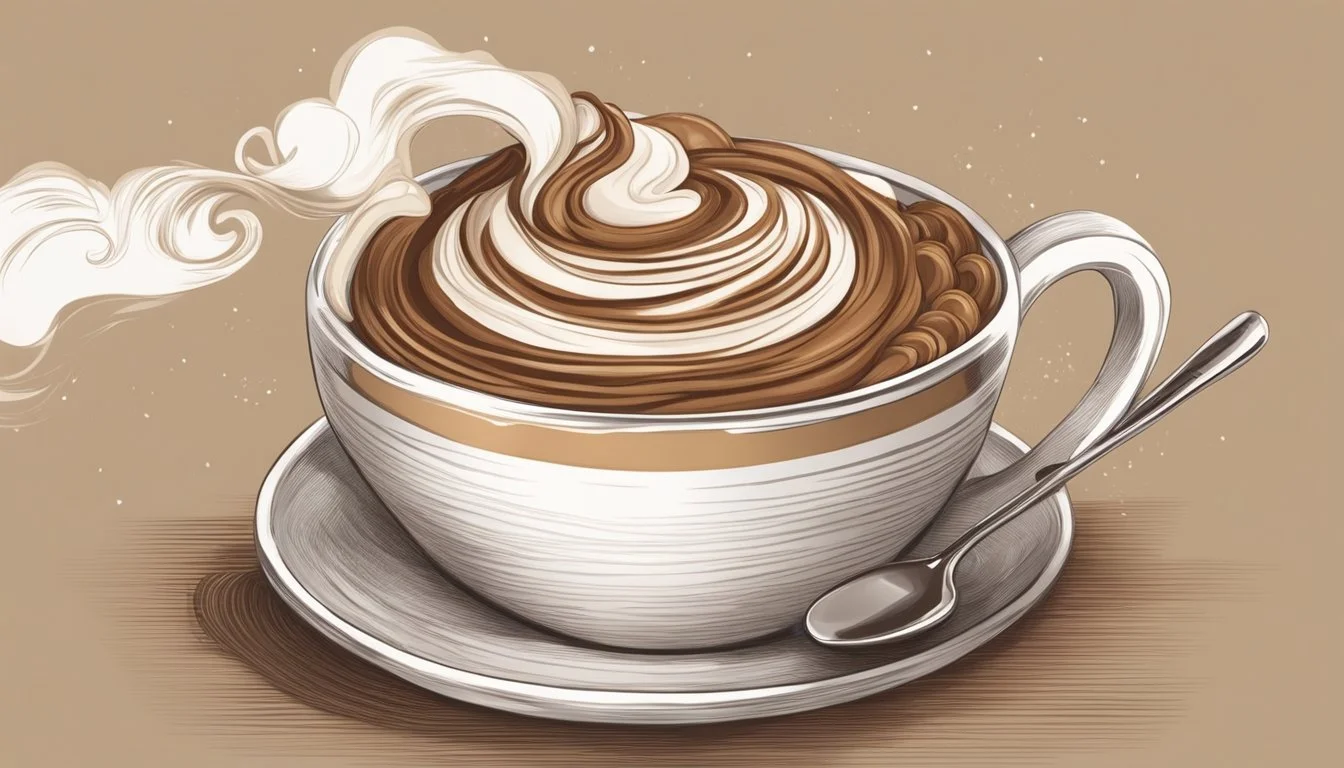How Do You Eat a Tiramisu Cake?
Mastering the Art of Dessert Enjoyment
Tiramisu cake is an elegant Italian dessert that has enamored taste buds around the globe. Traditionally crafted with layers of coffee-soaked sponge cake and a luxurious mascarpone cheese mixture, it is often dusted with cocoa powder for a bittersweet finish. Eating a tiramisu cake is an experience of balancing flavors and textures; the creamy mascarpone complements the moist layers of cake while the integral coffee and cocoa elements introduce a depth of flavor.
When it comes to consumption, tiramisu is typically served chilled, allowing the layers to set and the flavors to meld together. A dessert fork or spoon is the usual tool of choice to cut through the layers, ensuring each bite contains an even amount of cake, cream, and dusting. Given its richness and bold flavor profile, tiramisu is often enjoyed in small portions, making it a perfect finish to a meal or as a treat with an afternoon coffee.
Understanding Tiramisu
In exploring the layers of this luxurious Italian dessert, one will uncover a rich history, distinct layers, core ingredients, and the recipe’s cultural impact.
Historical Background
Tiramisu, which means "pick me up" in Italian, has origins often disputed but is commonly attributed to the Veneto region of Italy during the 1960s. This dessert is a testament to Italian culinary innovation, combining local ingredients to create a dish now integral to Italian gastronomy.
Defining Tiramisu
Tiramisu is an Italian dessert layered with delicate flavors and textures. It comprises alternating layers of coffee-soaked ladyfingers and a rich cream made from mascarpone, eggs, and sugar—often finished with a dusting of cocoa powder for a balance in flavor.
Key Ingredients
The typical Tiramisu recipe includes:
Espresso or strong coffee, for soaking ladyfingers and imparting the classic coffee flavor
Ladyfingers (Savoiardi biscuits), acting as the sponge layer
Mascarpone cheese, providing the creamy component
Eggs, which are separated; yolks for richness and whites for mousse-like texture
Sugar, to sweeten the mixture
Unsweetened cocoa powder, used for the topping
Cultural Significance
As an ambassador for Italian desserts, tiramisu holds a special place on menus, transcending Italy's borders to become a beloved treat worldwide. It reflects a slice of Italian culture, famous for blending simple, quality ingredients into extraordinary dishes. This dessert captures the essence of Italian hospitality and culinary heritage.
Ingredients Breakdown
When crafting a tiramisu cake, understanding the components that create its iconic taste is pivotal. Each ingredient serves a unique purpose to achieve the desired flavor and texture balance.
List of Ingredients
Mascarpone: A creamy cheese with a rich texture.
Espresso: Strongly brewed coffee, often cooled.
Cocoa powder: Fine powder used for dusting;
Eggs: Separated into yolks and whites for different uses.
Sugar: Granulated sugar for sweetness, powdered sugar for dusting.
Salt: Just a pinch to enhance flavors.
Vanilla Extract: Provides a sweet, creamy flavor.
Chocolate: Shaved or grated for garnishing.
Milk: Whole milk is preferable for richness.
Heavy Whipping Cream: Adds creaminess to mascarpone frosting.
Ladyfingers: Absorb coffee and layer the cake.
Butter: Used in the cake batter for moisture.
Coffee Liqueur: Optional for an extra kick, often included for adults.
Alcohol: Varieties like Marsala wine may be included in the recipe.
Pure Vanilla Extract: Used for mascarpone cream flavoring.
Kosher Salt: Sometimes preferred for its cleaner taste.
Role of Mascarpone in Tiramisu
Mascarpone, with its subtle sweetness and buttery texture, is the heart of tiramisu. It offers a luxurious mouthfeel that pairs with the coffee and complements the tender sponge of ladyfingers. When combined with egg yolks and sugar, mascarpone forms the central layer of mascarpone cream, providing the characteristic creaminess of a tiramisu cake.
Exploring Different Types of Coffee
Espresso grounds the flavor profile of tiramisu, delivering a deep, robust essence that contrasts with the sweetness of the other ingredients. While traditional tiramisu employs espresso, various preparations may explore different coffee intensities or blends. Some recipes include a coffee liqueur, enhancing the flavor complexity, or combine the coffee with Marsala wine or other alcohols to add richness and depth.
Preparation Essentials
Creating the perfect tiramisu cake hinges on three vital components: a well-baked sponge cake, a rich and creamy mascarpone filling, and a robust coffee mixture for soaking the cake layers.
Baking the Sponge Cake
To begin, one must gather flour, granulated sugar, large eggs, and baking powder—the essentials for crafting a fluffy sponge cake. The eggs should be at room temperature to ensure an even incorporation. Assembling the cake form, generally a springform pan, with a lining of parchment paper is also a crucial step. The batter is then poured into the prepared pan and baked until golden. Once removed from the oven, the cake should cool on a wire rack before handling further.
Ingredients:
Large eggs: at room temperature
Granulated sugar
Flour: sifted for a finer texture
Baking powder
Equipment:
Springform pan
Parchment paper
Wire rack for cooling
Whisking the Mascarpone Filling
For the mascarpone filling, one needs to combine egg yolks and sugar, whisking them until the color lightens. It is essential to use unsalted butter if opting for a richer taste. The mascarpone cheese is then added to this mixture. It's important to ensure the cheese and egg mix is smooth to avoid lumps in the filling. This creamy filling ultimately holds the layers of cake and coffee-soaked ladyfingers together.
Ingredients:
Egg yolks
Granulated sugar
Mascarpone cheese: full-fat for a richer filling
Unsalted butter (optional)
Tools:
Stand mixer with whisk attachment or hand mixer
Creating the Coffee Mixture
Lastly, the coffee mixture used for soaking is key in achieving the signature tiramisu flavor. One must combine either strong-brewed coffee or a solution of instant coffee with hot water to create this component. To add depth of flavor, a splash of dark rum or vanilla extract can be included. The liquid should be cooled to room temperature before the lady fingers are quickly dipped to infuse them without becoming too soggy.
Components:
Strong coffee or strong-brewed coffee
Dark rum or vanilla extract (optional)
Technique:
Quick dip of ladyfingers
Cool coffee mixture to room temperature
By meticulously following these steps, a tiramisu can be prepared with distinct yet harmonious layers, rich with the essence of coffee and the velvety texture of mascarpone cream.
Assembling the Tiramisu Cake
Assembling a tiramisu cake involves careful layering and achieving a balance between the textures and flavors. Mastery in crafting the perfect layers and creaminess is crucial to replicating the traditional tiramisu experience in a cake form.
Layering the Cake
The foundation of a tiramisu cake is in its layers. One begins by soaking ladyfingers in a rich coffee or espresso mixture, ensuring they are moist but not soggy. It's pivotal that the coffee is strong and at room temperature to imbue the layers with that signature tiramisu flavor without causing the ladyfingers to fall apart. The soaked ladyfingers form the first layer of the tiramisu cake, and they must be laid out neatly at the bottom of the pan.
Next, a generous amount of creamy mascarpone filling is spread over the ladyfingers. If one chooses to use a cake base instead of ladyfingers, the process remains similar: even layers of cake are alternated with the mascarpone cream. The use of a piping bag can aid in distributing an even layer of filling over the cake.
Achieving the Perfect Creaminess
The heart of tiramisu's allure is in its creamy mascarpone filling. To achieve the perfect creaminess, one must blend mascarpone cheese with a mixture of egg yolks and sugar that has been cooked until it thickens, then cooled. Care must be taken to ensure the mixture is smooth, with no lumps.
For a richer flavor profile, ingredients such as vanilla extract or a splash of Kahlua may be incorporated into the mascarpone cream. Once the blend is homogeneous and velvety, it's ready to layer onto the cake. The process is repeated, building up layer upon layer of soaked cake or ladyfingers and luscious mascarpone cream, finishing with a mascarpone layer.
It is essential that each layer is distinct and even, creating a harmonious balance between the moist espresso-soaked base and the rich, creamy mascarpone filling. A tiramisu cake assembled with precision not only delivers in taste but also presents beautifully when sliced, revealing the meticulous layers that characterize a well-crafted layered cake.
Decoration and Presentation
Decoration and presentation are crucial when serving tiramisu cake. They enhance the visual appeal and set the stage for an enjoyable dessert experience.
Applying the Final Touches
Before presenting, ensure the tiramisu cake has the perfect final touches. One should sift cocoa powder over the cake using a fine sieve for a classic finish. If it's a birthday or a special occasion, decorative elements like chocolate shavings or a dusting of powdered sugar can serve as a celebratory garnish. When using cocoa, remember that a light hand is key to prevent overpowering the more delicate flavors of the tiramisu.
Serving Suggestions
To serve, one should transfer the slices onto plates with care. If the cake was chilled on parchment paper, this will aid in a smooth release. Use a sharp, slim knife heated under hot water and dried to slice through the cake cleanly, ensuring layers remain intact. For an elegant presentation, a doily or a dessert plate with subtle patterning can complement the classic appearance of the tiramisu dessert. Each plate may be garnished with a sprig of mint or a few berries for a pop of color and freshness.
Advanced Techniques and Variations
The exploration of advanced techniques and variations allows for a tailored tiramisu experience, incorporating different flavors and catering to diverse dietary restrictions. Here, one can discover how to transform the classic tiramisu into something new or make it suitable for non-alcoholic preferences.
Alternative Tiramisu Flavors
Tiramisu's traditional coffee and chocolate harmony can be creatively expanded by introducing new flavors. Utilizing chocolate in diverse forms, such as white or dark chocolate shavings, can subtly change the taste profile. For a rich twist, chefs may include unique ingredients like matcha or raspberry for a colorful and flavorful variation.
Coffee Liqueur & Kahlua: Typically, tiramisu features coffee liqueur such as Kahlua for a deep, roasted flavor. However, one could also experiment with:
Hazelnut liqueurs
Amaretto for an almond note
Chocolate liqueurs for a double chocolate hit
Vanilla: A staple in most desserts, vanilla can be accentuated by using real vanilla beans or high-quality extract, lending a warm, floral note to the mascarpone cream.
Brandy: Some opt for a splash of brandy to give an additional depth of flavor that complements the lady finger cookies soaked in espresso.
Non-Alcoholic Substitutes
For those avoiding alcohol, there are suitable substitutes that maintain tiramisu's distinctive taste without compromising the integrity of the dessert.
Coffee or Espresso: Instead of coffee liqueur, strong brewed coffee or espresso can be used to soak the lady finger cookies. The key is to choose a bold, rich blend for maximum flavor.
Juices & Syrups: Non-alcoholic versions can also benefit from juices like cherry or pomegranate or syrups such as caramel or vanilla for added sweetness and complexity.
Alcohol-free extracts: Alcohol-free vanilla or chocolate extracts can replace liqueurs while still imparting the fullness of their intended flavors.
By weaving in different elements, from chocolate varietals to the infusion of distinct liqueurs, or the incorporation of non-alcoholic alternatives, the creation of tiramisu can be both a personal and dynamic culinary endeavor. Whether aiming for a robust flavor profile or a subtler dessert, these advanced techniques and variations can help to fine-tune the final product.
Storage and Serving Tips
Tiramisu cake is a delicate dessert that requires careful storage and serving to maintain its quality and flavor. The following tips ensure that this Italian treat can be enjoyed at its best.
How to Store Tiramisu Cake
To keep tiramisu cake fresh, it should be stored in the refrigerator. The cake must be kept cool to preserve its texture and prevent any bacterial growth. Ideally, one should store it in an airtight container to prevent the absorption of any other flavors or odors present in the refrigerator. Tiramisu should be consumed within 2 to 3 days for the best taste and quality.
Best Practices for Serving
When serving tiramisu, use a sharp knife dipped in hot water to slice cleanly through the layers. This method ensures smooth cuts without disrupting the intricate layers of mascarpone cheese and soaked ladyfingers. For the best presentation, use a flat spatula or pie server to lift out each slice and place it onto plates without losing the shape or layers.
Freezing and Thawing Advice
Freezing tiramisu can extend its shelf life; however, textures might be affected, particularly if whipped cream is used as it may separate or become grainy once thawed. To freeze, wrap the cake thoroughly in plastic wrap followed by aluminum foil and place it in the freezer. For consumption, tiramisu should be thawed overnight in the refrigerator, not at room temperature, to maintain its consistency and prevent melting of any creamy elements.
Health and Safety Considerations
When enjoying tiramisu cake, it is crucial to consider the health and safety aspects related to the ingredients and preparation methods. The following subsections address key safety concerns with raw eggs and provide essential allergy information.
Raw Eggs and Safety
Tiramisu traditionally contains raw eggs in its recipe, which may pose a risk of salmonella infection. To minimize this risk, one should use pasteurized eggs or heat the egg mixture to 160°F to kill any potential bacteria. Moreover, pregnant women, young children, the elderly, and individuals with compromised immune systems should avoid consuming raw eggs.
Eggs: Use pasteurized eggs to reduce the risk of contamination.
Temperature: Heat egg mixtures to at least 160°F.
Sea Salt: When making tiramisu, ensure that sea salt or other ingredients added to the egg mixture don't interfere with the cooking process that aims to ensure safety.
Allergy Information
Individuals with allergies should be mindful of the ingredients in tiramisu cake. The primary allergens include:
Eggs: Present in most tiramisu recipes.
Dairy: Contains mascarpone cheese and sometimes heavy cream.
Before consumption, individuals with food allergies or sensitivities should verify all ingredients used in the tiramisu, including cross-contamination risks if prepared in an environment that handles other allergens.
Final Thoughts
In this section, we focus on encapsulating the essence of indulging in a tiramisu cake and extend an invitation to embrace the art of creating this classic dessert.
Summarizing the Tiramisu Experience
Tiramisu cake is a symphony of flavors, layering coffee-soaked sponge with a rich mascarpone zabaglione. The depth of flavor in each bite comes from carefully crafted components, each contributing to a memorable dessert experience. The airiness of the cake complements the velvety mascarpone, which traditionally involves a zabaglione base—a whipped mixture of egg yolks, sugar, and Marsala wine.
Invitation to Try Making Tiramisu
Embarking on the journey of baking a tiramisu cake recipe is both rewarding and an enlightening culinary adventure. Aspiring bakers are encouraged to follow the tiramisu recipe with an eye for detail, applying expert tips such as using the freshest ingredients for a richer taste and ensuring the egg whites are whipped to stiff peaks for optimal texture. Whether one prefers the classic layered approach or the adaptation of this Italian dessert into a cake form, the process of making tiramisu is an art worth mastering.









